Seven things to look out for at E3 Harelbeke and Ghent-Wevelgem
What to keep your eye on at this weekend's cobbled Classics...
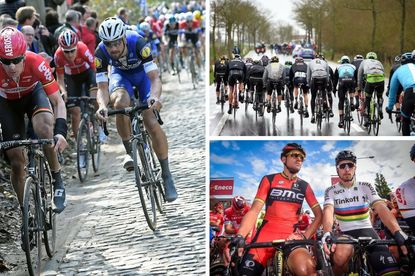
Tour of Flanders dry run at the E3 Harelbeke
Can’t wait for the Tour of Flanders? Then be sure to tune into the E3 Harelbeke on Friday.
Of all the Belgian cobbled Classics that precede the Ronde, the E3 is the one that most resembles it. Both races share some of the region’s most famous bergs, with the Oude Kwaremont and Paterberg playing particularly crucial roles in both.
>>> Iconic Places: The Kemmelberg in Ghent-Wevelgem
Of course E3 Harelbeke isn’t as difficult as the Ronde - at 204.6km in length it’s about 20 per cent shorter, and features fewer climbs in total, but it’s still one of the toughest and most exciting of the spring, and will attract all the top Classics stars.
Held only nine days before Flanders, it’s also a great barometer of a contender’s form. In four of the past five years, the winner of Flanders has finished no lower than fourth at the E3.
Crosswinds and the Kemmelberg at Ghent-Wevelgem
Get The Leadout Newsletter
The latest race content, interviews, features, reviews and expert buying guides, direct to your inbox!
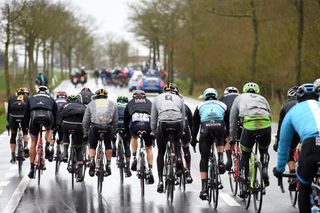
Ghent-Wevelgem is considered an easier Classic than the E3 these days, and does indeed produce large bunch sprints at more regular intervals. But the last two editions demonstrate the two factors that can shake things up: crosswinds, and the Kemmelberg climb.
The 2015 edition was one of the most memorable in the race’s 87-year history thanks to the gale force winds that blew the race to pieces, causing huge splits very early on, nearly blowing some riders of their bikes altogether, and resulting in the riders arriving at the finish line exhausted and in dribs and drabs.
Last year, the winning selection was made on the Kemmelberg, the race’s most famous climb for the difficulty of its cobbled slope and eerie atmosphere of the overhanging trees that surround it, as well as its infamously treacherous descent.
Positioned 34km from the finish, it’s often dismissed these days as being too far from the finish to really effect the race, but last year proved that the combined strength of powerful enough riders - in that case, Peter Sagan, Fabian Cancellara and Sep Vanmarcke - can be enough for attacks over it to survive to the finish.
Peter Sagan vs Greg Van Avermaet
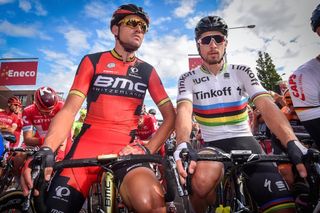
If the first weekend of cobbled racing this season was anything to go by, Peter Sagan (Bora-Hansgrohe) and Greg Van Avermaet (BMC) are the ones to watch in the rest of this spring’s northern Classics, with the former winning Omloop Het Nieuwsblad and the latter Kuurne-Brussels-Kuurne.
Theirs is a rivalry that has grown over the past few years, with Van Avermaet being the rider Sagan appears to have most difficulty getting the better of in a head-to-head showdown. Van Avermaet's out-sprinting of Sagan at Het Nieuwsblad last month the sixth time he has beaten him into second over the past twenty months.
Both are on the start list for E3 Harelbeke and Ghent-Wevelgem, and will be eager to land a psychological blow over the other.
Sky looking for E3 hat-trick
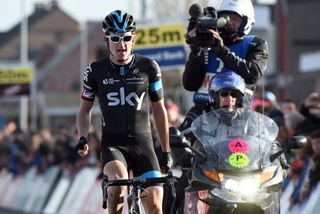
The E3 Harelbeke is a race Sky have enjoyed considerable success at recently, with Geraint Thomas winning with an impressive solo move in 2015, and Michal Kwiatkowski outfoxing Sagan to win last year’s edition.
Neither rider will be present this year, but Sky still boast the formidable duo of Ian Stannard and Luke Rowe.
There’s a sense that we haven’t yet seen the best of either rider this spring as they gradually build up their form, but, if the last two years are anything to go by, this Friday’s E3 could be the moment for them to lay down a marker.
Sprinters eye up Ghent-Wevelgem
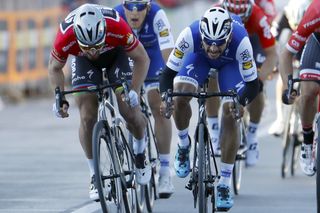
Both line-ups for the E3 and Ghent-Wevelgem look very similar, with most of the top Classics stars opting to compete in both, but there are some sprinting specialists opting to skip the former and only ride in the latter.
Caleb Ewan (Orica-Scott), Michael Matthews (Sunweb) and Fernando Gaviria (Quick-Step Floors) are the three most notable names riding just Ghent-Wevelgem, joining John Degenkolb (Trek-Segafredo) and Arnaud Démare (FDJ) (who are riding both), meaning there will be plenty of teams attempting to keep things together for a sprint.
The aforementioned Kemmelberg and potential crosswinds could make their task difficult, but each rider is, if on top form, capable of winning.
Can Quick-Step Floors get it right?
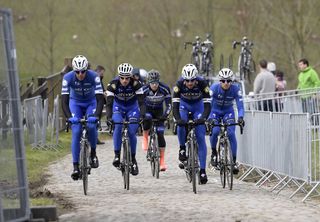
A familiar theme in the spring Classics of recent years has been Quick-Step Floors’ failure to translate their strength in depth into wins.
The omens don’t look great - their highest placed rider in the Omloop Het Nieuwsblad/Kuurne-Brussels-Kuurne weekend was fifth from Matteo Trentin in the latter, and they’ve haven’t won either E3 Harelbeke or Ghent-Wevelgem since 2012.
That said, they are still bringing very strong squads to both races, with multiple cards to play. The rouleur Niki Terpstra, puncheur Zdenek Stybar, and quick sprinters Tom Boonen and Matteo Trentin, with the addition of the even quicker Fernando Gaviria for just Ghent-Wevelgem and Belgian champion Philippe Gilbert for E3 Harelbeke.
Women’s Ghent-Wevelgem

Lizzie Armitstead climbs the Paterberg ahead of breakaway companion Emma Johansson in the Women's Tour of Flanders. The pair would contest a sprint to the line with the world champion just edging it to take her first win in the Classic.
The women’s Ghent-Wevelgem also takes places this weekend, a key race on the calendar as the fourth leg of the Women’s WorldTour, and the last cobbled event in the series before the highlight of the Tour of Flanders.
Since its inception in 2012 it’s proved to be a selective race fruitful for solo attacks, with Lizzie Deignan winning the inaugural edition with a lone attack of 25km, and Floortje Mackaij and Chantal Blaak claiming the past two editions by taking off the front alone.
The race may end with a long, 41km flat run-in to the finish, but the severity of the climbing prior to that (and, potentially, the weather) tends to do break the race into pieces early on, with two ascents of the Kemmelberg and Monteberg and one ascent of the Baneberg concentrated within just 34km.
Last year’s winner Blaak is part of a very strong Boels-Dolmans team that also includes world champion Amalie Didereksen and Olympic champion Anna van der Breggen, while the on-form Lucinda Brand (Sunweb), quick sprinter Jolien d’Hoore (Wiggle High5) and Marianne Vos (WM3 Energie) are among the other major riders to look out for.

Thank you for reading 20 articles this month* Join now for unlimited access
Enjoy your first month for just £1 / $1 / €1
*Read 5 free articles per month without a subscription

Join now for unlimited access
Try first month for just £1 / $1 / €1
Stephen Puddicombe is a freelance journalist for Cycling Weekly, who regularly contributes to our World Tour racing coverage with race reports, news stories, interviews and features. Outside of cycling, he also enjoys writing about film and TV - but you won't find much of that content embedded into his CW articles.
-
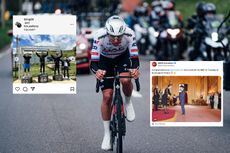 Tweets of the week: Pogačar can be beaten, Pidcock meets the royals, and Remco's an Arsenal fan
Tweets of the week: Pogačar can be beaten, Pidcock meets the royals, and Remco's an Arsenal fanSadly for Tadej Pogačar, serial winning doesn't seem to apply to go karting
By Tom Davidson Published
-
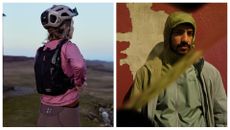 Friday roundup: Rapha does sportswear, Oakley meets PNS and Restrap makes a vest
Friday roundup: Rapha does sportswear, Oakley meets PNS and Restrap makes a vestTwo new clothing lines, some hi-tech smart glasses and a hydration vest to inspire you to ride further
By Luke Friend Published
-
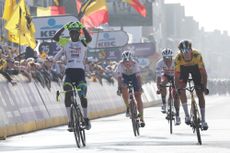 Biniam Girmay takes momentous sprint victory at Gent-Wevelgem
Biniam Girmay takes momentous sprint victory at Gent-WevelgemThe Eritrean etched his name in history as the first African rider to win the spring classic.
By Tom Davidson Last updated
-
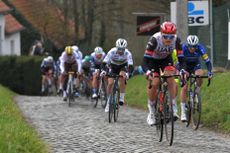 How to watch Omloop Het Nieuwsblad 2022: Live stream the first cobbled Classic of the season
How to watch Omloop Het Nieuwsblad 2022: Live stream the first cobbled Classic of the seasonIf you can't be in Belgium for Opening Weekend you might as well watch it on the TV
By Jonny Long Published
-
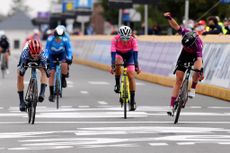 Trek-Segafredo back to winning ways as Ruth Winder takes Brabantse Pijl
Trek-Segafredo back to winning ways as Ruth Winder takes Brabantse PijlUS national champion Ruth Winder won the tightest of sprints at Brabantse Pijl on Wednesday (April 14).
By Owen Rogers Published
-
 Lorena Wiebes wins in a bunch sprint at a wind ravaged women's Scheldeprijs
Lorena Wiebes wins in a bunch sprint at a wind ravaged women's ScheldeprijsTeam DSM win the battle of the lead outs after a scrappy final in the Belgian wind and rain
By Owen Rogers Published
-
 Groupama-FDJ pull out of Scheldeprijs 2021 after Covid-19 positive
Groupama-FDJ pull out of Scheldeprijs 2021 after Covid-19 positiveGroupama-FDJ have had to pull out from racing at the Belgian one-day race of Scheldeprijs due to a positive Coronavirus test within the team
By Tim Bonville-Ginn Published
-
 Annemiek van Vleuten wins the Tour of Flanders with a signature long range move
Annemiek van Vleuten wins the Tour of Flanders with a signature long range moveAnnemiek van Vleuten won the Tour of Flanders for the second time with a signature attack on Sunday.
By Owen Rogers Published
-
 Tour of Flanders 2021 start lists
Tour of Flanders 2021 start listsFull list of riders taking part in the 2019 edition on Sunday, April 7
By Jonny Long Published
-
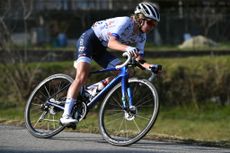 'Risk big and you win big,' Cecilie Uttrup Ludwig willing to risk all at the Tour of Flanders
'Risk big and you win big,' Cecilie Uttrup Ludwig willing to risk all at the Tour of FlandersAfter finishing third in 2019 the Danish rider has a stronger team than ever to help achieve a first WorldTour win
By Owen Rogers Published